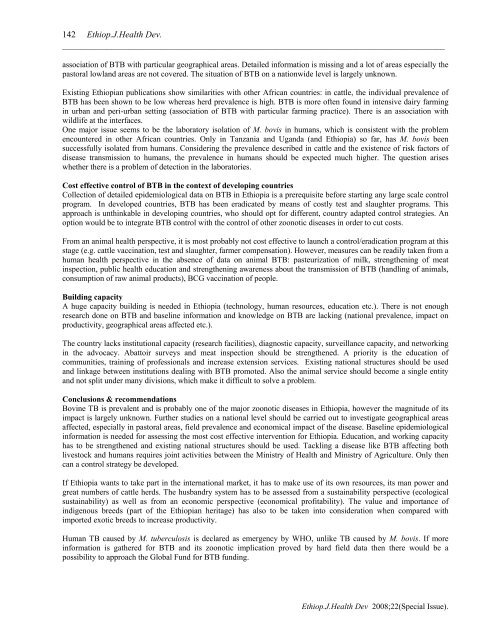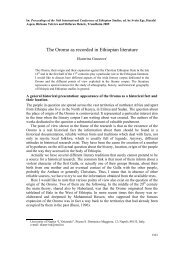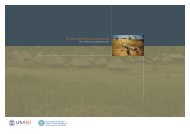You also want an ePaper? Increase the reach of your titles
YUMPU automatically turns print PDFs into web optimized ePapers that Google loves.
142 Ethiop.J.Health Dev.<br />
______________________________________________________________________________________<br />
association of BTB with particular geographical areas. Detailed information is missing and a lot of areas e<strong>special</strong>ly the<br />
pastoral lowland areas are not covered. The situation of BTB on a nationwide level is largely unknown.<br />
Existing Ethiopian publications show similarities with other African countries: in cattle, the individual prevalence of<br />
BTB has been shown to be low whereas herd prevalence is high. BTB is more often found in intensive dairy farming<br />
in urban and peri-urban setting (association of BTB with particular farming practice). There is an association with<br />
wildlife at the interfaces.<br />
One major issue seems to be the laboratory isolation of M. bovis in humans, which is consistent with the problem<br />
encountered in other African countries. Only in Tanzania and Uganda (and Ethiopia) so far, has M. bovis been<br />
successfully isolated from humans. Considering the prevalence described in cattle and the existence of risk factors of<br />
disease transmission to humans, the prevalence in humans should be expected much higher. The question arises<br />
whether there is a problem of detection in the laboratories.<br />
Cost effective control of BTB in the context of developing countries<br />
Collection of detailed epidemiological data on BTB in Ethiopia is a prerequisite before starting any large scale control<br />
program. In developed countries, BTB has been eradicated by means of costly test and slaughter programs. This<br />
approach is unthinkable in developing countries, who should opt for different, country adapted control strategies. An<br />
option would be to integrate BTB control with the control of other zoonotic diseases in order to cut costs.<br />
From an animal health perspective, it is most probably not cost effective to launch a control/eradication program at this<br />
stage (e.g. cattle vaccination, test and slaughter, farmer compensation). However, measures can be readily taken from a<br />
human health perspective in the absence of data on animal BTB: pasteurization of milk, strengthening of meat<br />
inspection, public health education and strengthening awareness about the transmission of BTB (handling of animals,<br />
consumption of raw animal products), BCG vaccination of people.<br />
Building capacity<br />
A huge capacity building is needed in Ethiopia (technology, human resources, education etc.). There is not enough<br />
research done on BTB and baseline information and knowledge on BTB are lacking (national prevalence, impact on<br />
productivity, geographical areas affected etc.).<br />
The country lacks institutional capacity (research facilities), diagnostic capacity, surveillance capacity, and networking<br />
in the advocacy. Abattoir surveys and meat inspection should be strengthened. A priority is the education of<br />
communities, training of professionals and increase extension services. Existing national structures should be used<br />
and linkage between institutions dealing with BTB promoted. Also the animal service should become a single entity<br />
and not split under many divisions, which make it difficult to solve a problem.<br />
Conclusions & recommendations<br />
<strong>Bovine</strong> TB is prevalent and is probably one of the major zoonotic diseases in Ethiopia, however the magnitude of its<br />
impact is largely unknown. Further studies on a national level should be carried out to investigate geographical areas<br />
affected, e<strong>special</strong>ly in pastoral areas, field prevalence and economical impact of the disease. Baseline epidemiological<br />
information is needed for assessing the most cost effective intervention for Ethiopia. Education, and working capacity<br />
has to be strengthened and existing national structures should be used. Tackling a disease like BTB affecting both<br />
livestock and humans requires joint activities between the Ministry of Health and Ministry of Agriculture. Only then<br />
can a control strategy be developed.<br />
If Ethiopia wants to take part in the international market, it has to make use of its own resources, its man power and<br />
great numbers of cattle herds. The husbandry system has to be assessed from a sustainability perspective (ecological<br />
sustainability) as well as from an economic perspective (economical profitability). The value and importance of<br />
indigenous breeds (part of the Ethiopian heritage) has also to be taken into consideration when compared with<br />
imported exotic breeds to increase productivity.<br />
Human TB caused by M. tuberculosis is declared as emergency by WHO, unlike TB caused by M. bovis. If more<br />
information is gathered for BTB and its zoonotic implication proved by hard field data then there would be a<br />
possibility to approach the Global Fund for BTB funding.<br />
Ethiop.J.Health Dev <strong>2008</strong>;22(Special Issue).







